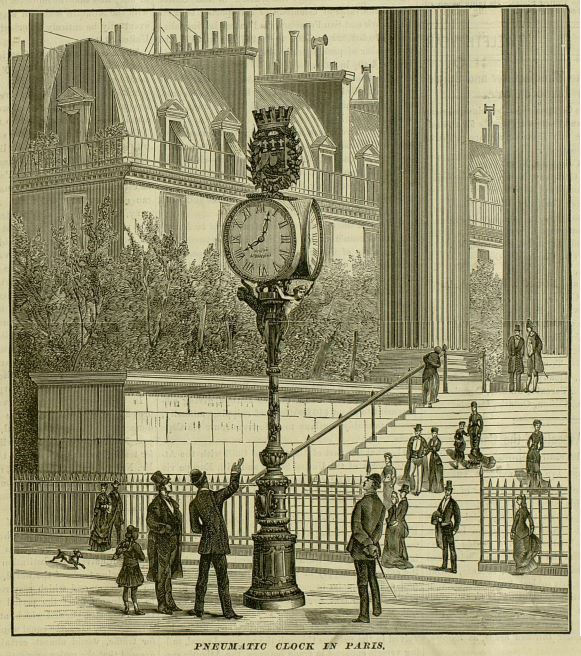When French-born but London-based civil and electrical engineer, Jules Albert Berly, traveled to Paris for the 1881 International Exposition of Electricity, he saw many wonderous exhibits such as incandescent lamps, the Théâtrophone, the electric tramway, Graham Bell’s telephone, an electrical distribution network, an electric boat and many more fascinating cutting-edge technology of the time. But the thing that captivated him the most did not run on electricity. It ran on air.
Berly was entranced by a system of clocks that stood on “graceful light iron pillars in the squares, at the corners of streets, and in other conspicuous positions about the city,” as well as those in hotels, each keeping—what was unusual in that age—”accurate time”. These remarkable timekeepers were not powered or regulated by electricity, but by compressed air that was sent from a central station through wrought iron pipes to all public clocks operated in this fashion.
A multiple-faced pneumatic clock in the Place de la Madeleine, Paris.
This network of pneumatic clocks was first installed in Vienna in 1877 as a demonstration by two Austrian engineers, Viktor Antoine Popp and his co-worker Resch. Popp and Resch installed a number of clocks in public buildings and on lamp-posts in public thoroughfares, and kept them working uninterruptedly for a whole year. Popp and Resch then exhibited their system at the Paris Exhibition in 1878, where it attracted much attention, and the jury awarded them a silver medal. That same year, Popp and Resch obtained from the Paris municipal authorities the authorization to install a compressed air network to drive both public and private clocks.
The pneumatic clock network was not a power distribution network but a time distribution network, which synchronized a large number public clocks by sending a pulse of air every minute. The pipes ran through the sewers of the city, and the tunnels of the Metro and the RER, a commuter rail network serving Paris and its suburbs. Each clock contained a metal bellows which advanced a 60-tooth wheel by one tooth per minute. Compressed air from the plant left at a pressure of 15 to 45 pounds per square inch (about 1 to 3 atmospheres) for storage in a high-pressure air tank. From there it travelled through a pressure regulator to a low-pressure storage tank or accumulator. Its release was controlled by a distributing clock. The driving weights were lifted by compressed air to keep the clock running and on time. An automatic timing mechanism opened a valve to release a 20-second pulse of air every minute and then the valve closed for 40 seconds. The 20-second-on, 40-second-off cycle was repeated every minute. The pulse of air travelled to every receiving clock, be it in a private home or office or in a street or public building, and advanced the minute hand by one minute. The system worked uninterrupted 24 hours a day, 7 days a week.
A pneumatic clock in Paris.
By the time Jules Berly visited Paris for the International Exposition, nearly 20 miles of main pipes and 177 miles of branch and sub branch pipes had been laid, serving 750 houses and over 4,000 pneumatic clock.
The clocks served Paris exceptionally well until the great flood of 1910, when the Seine rose high enough to flood the compressed air plant and on 21 January 1910 at 10:53 a.m., the thousands of clocks on the system stopped. However, the system was repaired and pneumatic clocks continued to work until 1927, when the invention of accurate mechanical and electric clocks made the need for a central synchronization clock obsolete, and the service was discontinued.
References:
# The Paris Pneumatic Clock Network, Museum of Retro Technology
# Norman Ball, A question of time, Parisian Fields
# Jules Albert Berly, The Distribution of Time by a System of Pneumatic Clocks, The American Architect and Building News














Comments
Post a Comment